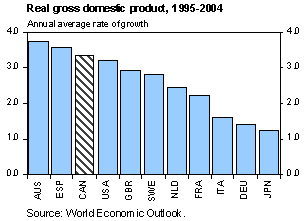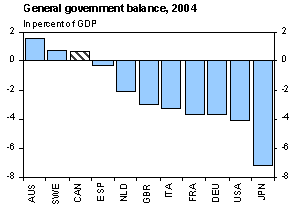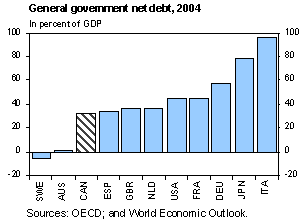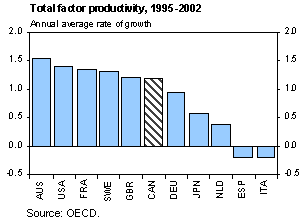Canada -- 2006 Article IV Consultation, Preliminary Conclusions of the IMF Mission
December 2, 2005
1. Canada's macroeconomic performance remains impressive across a broad range of indicators. Supported by higher commodity prices, strength in trading partners, and despite the rise of the Canadian dollar, growth has been brisk. Unemployment has fallen to a 30-year low, underlying inflation has been contained, and the fiscal and external current account balances remain in surplus. This success has rested importantly on Canada's strong policy framework. Inflation targeting has kept expectations firmly anchored even in the face of higher energy prices, providing the Bank of Canada with room to maneuver as it withdraws stimulus. The long-standing commitment to "budget balance or better" has allowed Canada to achieve the largest reduction in its public debt/GDP ratio among the main industrial countries since the mid-1990s, and allowed budget resources to be shifted from debt service to tax cuts and other priorities.
 |
2. The outlook appears favorable, buoyed by the boom in world commodity prices, but Canada remains highly dependent on global economic developments. We expect GDP to increase by about 3 percent this year and next, as the support to activity from high commodity prices balances the pressures on noncommodity exporters from currency appreciation, with inflation returning close to the 2 percent target by end-2006. While the low household saving rate remains a concern, the key risks are external. In particular, Canada's openness to foreign trade, exposure to commodity prices, and close ties to the U.S. economy have brought enormous benefits, but also leave it especially vulnerable to a disorderly resolution of global external imbalances.
3. Against this background, the key challenge remains to improve the economy's flexibility and to support long-term growth. Canada's productivity performance has been disappointing in recent years, with estimates suggesting a still significant gap with the level in the United States, and an improvement will be needed to help cope with the effects of the coming retirement of the baby boom generation on the labor supply and social programs. Economic flexibility remains key to maximizing the benefits from Canada's plentiful natural resources in the face of recent commodity price increases, and to enabling the economy to respond to the uncertainties that surround the global environment and prospects. These challenges underline the importance of continuing to pursue sound macroeconomic policies while intensifying the focus on policies to improve economic efficiency.
|
Monetary policy and the inflation targeting framework 4. We agree with the Bank of Canada that a further withdrawal of stimulus will be required in coming months. Most indicators suggest that the economy is operating at capacity, headline CPI inflation is above 2 percent, and there are signs of skill shortages in the resource and construction sectors. With overnight interest rates below most estimates of the neutral rate, market expectations of further rate hikes over the next few fixed action dates appear appropriate. More broadly, well-anchored inflation expectations and limited underlying price pressures should allow the Bank to withdraw stimulus in a manner that takes account of emerging macroeconomic developments and risks. 5. The inflation targeting (IT) framework remains an effective and successful anchor for monetary policy, suggesting no obvious need for significant amendments when it is renewed next year. The existing regime has widespread public support, which the Bank has effectively nurtured with continued improvements in policy transparency, most recently by providing more detail on the outlook and surrounding uncertainties in its Monetary Policy Reports. We welcome the comprehensive review of the IT regime that the Bank has initiated and the search for further refinements, although the credibility and success of existing arrangements suggest a high burden of proof on proposals for significant changes.
Fiscal policy framework 6. Canada's fiscal framework has continued to deliver an enviable performance relative to other industrial countries. The commitment to "budget balance or better" has yielded federal surpluses for eight consecutive years that have reduced government debt, delivered a fiscal dividend that has afforded substantial tax relief, and helped create a strong social consensus for fiscal prudence. Coupled with past reforms of the Canada Pension Plan, as well as balanced budget rules in many provinces, Canada is better placed than most other countries to cope with the long-term fiscal challenges from population aging.
7. The 2005 Budget and subsequent Fiscal Update provided a welcome reaffirmation of the commitment to fiscal transparency, prudence, and continued debt reduction. We particularly welcomed the careful response to the recommendations of the O'Neill report, that clearly illustrated that large fiscal surpluses have at least partly reflected the asymmetric nature of the commitment to avoid deficits coupled with uncertainties surrounding end-year budget forecasts. However, the proposal to address this issue by allocating surpluses beyond the Contingency Reserve equally to tax cuts, spending priorities, and debt reduction could detract from the simplicity of existing commitments and lend a procyclical bias to budget policy. As we have observed in the past, a debt objective can provide a useful medium-term anchor to the budget path. It would be helpful, therefore, to complement the new debt target set for 2020 by maintaining interim goals, while the social consensus for a declining debt ratio could be reinforced through a regular fiscal sustainability report illustrating the challenge posed by long-term spending pressures. 8. After the significant boost to social spending that has occurred in recent years, it is appropriate to shift the policy emphasis toward improving economic efficiency. In this respect, the focus on reducing the tax burden and supporting education, innovation, and immigration proposed in the Update is welcome. Planned cuts in corporate rates and the early elimination of the federal capital tax are particularly appropriate given the relatively high level of Canada's marginal effective tax rates. At the same time, while the fiscal outlook has brightened considerably since last year, this improvement partly reflects higher commodity prices and corporate profits whose permanence is uncertain. These considerations, together with the uncertainties that surround fiscal forecasts, suggest the importance of resisting pressures to erode the modest planning surpluses projected over the medium term, possibly by maintaining larger "prudence factors." 9. Notwithstanding significant increases in federal transfers in recent years, health care reforms are still needed to ensure the sustainability of the public health care system. Provincial/territorial health outlays are rising at a rapid rate and the system remains under considerable stress, as underscored by a recent Supreme Court decision on excessive wait times. Health Accords have locked in health transfers for a 10-year period and will-if firmly adhered to-provide both the incentive and an opportunity for provinces to strengthen the supply side of the health system and improve its cost-effectiveness. At the same time, there remains a case for allowing provinces greater flexibility to introduce mechanisms to better align the demand for health care with available resources. 10. Helpful steps have already been taken to reduce the volatility of equalization payments. An expert panel is presently considering alternative allocation rules that would make payments to individual provinces more stable and ensure that they appropriately reflect revenue capacity. However, the recent boom in global commodity prices has highlighted that the current framework plays a relatively modest role in addressing regional disparities in capacity stemming from oil and gas production. Thus, while it is important that equalization payments do not discourage development of new capacity, there would seem to be merit in ensuring that a new allocation formula takes resource-based revenues into account. Increasing economic efficiency
11. Although Canada has been among the fastest growing industrial countries in recent years, its productivity performance has been less encouraging. The causes for this remain unclear, but may include weak investment, labor market rigidities, regulatory constraints, and trade policies. Looking ahead, the economy will face a difficult challenge in re-allocating labor and capital between regions and industries in the face of the sharp appreciation of the Canadian dollar and higher commodity prices, while recent announcements in the automobile sector illustrate the importance of responding flexibly to globalization. A recent Senate report has underscored the role of policy initiatives in achieving these objectives. In our view, priorities include: · Improving incentives to invest and save. Even after recent proposals for tax relief, the Canadian tax system would still place a relatively large burden on income rather than consumption, which may undermine incentives to save and invest, and weigh on revenues as the share of retirees grows. The corporate tax burden is high, which has helped spur the use of income trusts, and provincial capital taxes and sales taxes may also dampen investment. Thus, if fiscal positions allow, consideration could be given to further lowering the marginal corporate rate, continuing to align capital cost allowances with economic depreciation rates, and harmonizing provincial sales taxes with the GST. On the personal income side, it would be desirable to consider further reducing top marginal income tax rates and increasing RRSP limits. · Reducing labor market rigidities. Recent years have seen a significant rolling back of earlier reforms to the Employment Insurance system and care will be needed to avoid allowing new pilot projects to result in a further erosion of labor market flexibility. The recent proposal to reduce welfare walls is welcome and-as in the case of the National Child Benefit-should facilitate better coordination of federal and provincial assistance programs. Similarly, there would still seem scope to refine benefit formulas in the Canadian Pension Plan in ways to ensure that they do not unduly discourage the elderly to remain active in the labor force. Finally, the skill shortages that have emerged in certain regions underline the possible benefits of a more flexible immigration system and reducing provincial barriers to the recognition of occupational qualifications. · Reducing barriers to competition. International comparisons suggest room to reduce Canada's regulatory burden. The requirements of the Investment Canada Act, including sector-specific constraints and thresholds for review, seem outmoded and may discourage foreign direct investment that can enhance productivity and innovation. Progress could also be made in areas such as the utility sector, where productivity growth has been lower and markups higher than in many industrial countries. · Trade liberalization. Canada can play an important leadership role in completing the Doha Round, particularly by widening market access for agricultural goods, including those subject to "supply management" schemes. Canada's revised offer could help galvanize negotiations in the service sector. 12. The boom in world oil prices and recent off-shore discoveries represent an important opportunity for Canada that will need to be managed carefully. Substantial fiscal and other benefits will accrue to oil producing regions and, as noted above, it will be helpful if the revisions to the equalization system appropriately recognize their improved revenue capacity. At the same time, the resources that are generating this windfall are limited, and their exploitation may involve significant environmental and other costs. On the fiscal side, provinces should place a priority on husbanding carefully the new financial resources that will accrue, while Canada will have an important opportunity to demonstrate its leadership in addressing the environmental challenges at the forthcoming Montreal Summit. 13. The financial system appears to be well placed to support growth. With high profitability, robust balance sheets, adequate provisioning, and sophisticated supervision and regulation, the financial system appears sound. However, further enhancements could improve the system's efficiency and resilience, as well as Canada's competitiveness in a rapidly globalizing world: · Bank mergers. There remains considerable debate regarding the efficiency gains that might result from mergers among Canada's large financial institutions, and how these might be weighed against competitiveness and other considerations. Nonetheless, greater clarity regarding merger applications would help reduce business uncertainty, and would allow for a more transparent process for the examination of the potential benefits and costs of merger proposals. · Securities regulation. Harmonizing securities regulation would reduce compliance and administrative costs while simplifying rule making and supervision. This could be most easily accomplished by establishing a national securities regulator, as was argued in the report by the Wise Persons' Committee, which would also enhance investigation and enforcement. · Defined benefit pension plans. Recent data suggest that the funding situation of many of Canada's defined benefit plans has deteriorated further over the past year, despite the relatively favorable cyclical conjuncture. The recent decision to enter into a public consultation on regulatory reform is welcome and early action is needed to better align the incentives of plan sponsors and members to improve funding of the system. 14. Canada is to be commended for its efforts towards debt relief and development but is urged to raise the level of its Official Development Assistance (ODA) towards the international benchmark of 0.7 percent of gross national income. We welcome Canada's leadership role in debt relief efforts and its plans to double its International Assistance Envelope by the end of the decade. Although Canadian ODA as a share of gross national income is around the OECD average and has increased recently, the ratio remains below the international benchmark. * * * 15. Our discussions have taken place against the background of possible elections and we look forward to continuing our constructive and candid dialogue on Canada's policy challenges. |
IMF EXTERNAL RELATIONS DEPARTMENT
| Public Affairs | Media Relations | |||
|---|---|---|---|---|
| E-mail: | publicaffairs@imf.org | E-mail: | media@imf.org | |
| Fax: | 202-623-6278 | Phone: | 202-623-7100 | |





